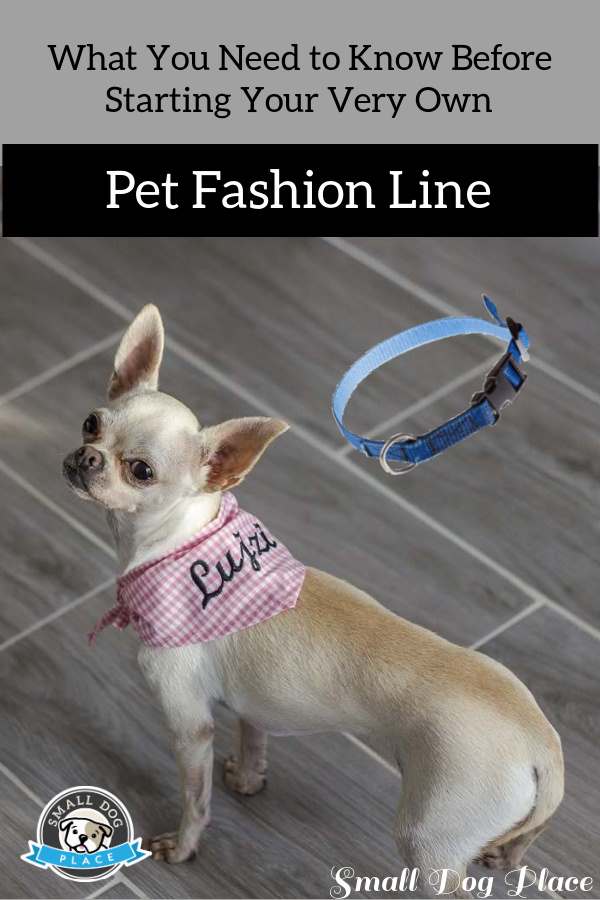- Small Dog Place Home
- Lifestyle
- Pet Fashion Line
What You Need to Know Before Starting Your Very Own Pet Fashion Line
Pet Fashion Line by Sherry Jane Smith
|Last updated 05-24-2023
The pet product industry is booming. With more and more households welcoming pets into their homes, spending for our furry friends is currently at an all-time high and still climbing.
Over 60 percent of all households in America have at least one pet, according to the latest U.S. Pet Ownership Statistics report conducted by the American Veterinary Medical Association (AVMA).
Pin for Future Reference
 Pet Fashion Line: Pin for Future Reference
Pet Fashion Line: Pin for Future ReferenceFurthermore, pet parents in the United States are projected to spend an estimated USD 99 billion on pet-related products and services for their fur babies this year, up from last year’s total of USD 95.7 billion, as per the American Pet Products Association (APPA). These numbers are only expected to rise in the years to come.
Starting Your Own Pet Fashion Line

It all should be enough to convince any enterprising, fashion-forward animal lover to launch that special passion project they’ve had knocking around in the back of their mind for a while.
However, opening any business is a task not to be undertaken lightly. Before dreaming up a name for your pet apparel line and placing bulk orders for customizable dog leashes, sweaters, and shoes, it’s important first to get all of your ducks in a row. Here’s everything you need to know before starting your very own pet fashion line:
Figure Out What You Want to Offer

The pet apparel industry has seen significant growth in recent years, thanks mainly to pet humanization trends and changing pet ownership attitudes.
People nowadays perceive their pets as family members, creating a high demand for products and services that enable their furry companions to enjoy life in the same way that we humans do. This means that competition in this particular area of the industry can be remarkably fierce.
Indeed, pet fashion brands don’t just sell sweaters or shirts anymore. There are tens of thousands of others out there that offer everything from hats to hoodies to bandanas.
Some even sell full costumes for pets for every imaginable holiday out there, complete with footwear. As such, setting your pet fashion line apart from your competitors will take some doing.
That’s why it’s important to consider what you can bring to the table before embarking on this venture. It simply isn’t enough to offer a great product when countless others also offer high-quality pieces. Your's must be unique and supply a need that isn't being offered elsewhere.
The most important question to ask yourself at this juncture would be this: what would set your product apart and make people want to purchase it?
Determine How You’d Like to Execute Your Business
Most people who want to go into the pet fashion industry typically already have some knowledge and experience designing and producing apparel.
In addition to knowing how to sketch designs and measure and cut patterns, being familiar with how to work a sewing machine or stitch pieces by hand is also an asset.
If you do not possess these skills, it’s a good idea to start familiarizing yourself with them now. Alternatively, you can team up with an experienced seamstress who can help bring your designs to life.
Alternately, you may enjoy needle arts and enjoy creating patterns for handknit dog sweaters. Alternately, if you love to knit or crochet more than you enjoy designing patterns, you might want to offer your creations at local craft fairs or set up an Etsy Shop.
Another big decision you’ll have to make is whether you want to sell your garments at a brick-and-mortar boutique or through an online storefront. Each has its pros and cons that you’ll need to take into account.

Brick and Mortar Shop
A brick-and-mortar shop firmly positions your brand as a presence in the community.
Through it, you’ll be able to interact and form relationships with your customers more directly.
However, opening a retail location comes with certain overhead costs such as rent and utilities. You may also have to hire enough staff to staff your store. This is a huge undertaking and one you may not enjoy in the long run.
Online Shopping Sites
On the other hand, you can do away with these costs if you choose to sell your fashionable pet products online. You’ll also be able to expand your reach to include customers who may not live in your area.
Competition online is much fiercer, but you also have a much larger audience to view your creations. The old saying, "If you build it, they will come," is not true in the online community.
Building a brand takes fierce determination, hard work, and passion. It doesn't happen over night and there is a step learning curve when it comes to being successful online.
Skills You Need to Develop to Be Successful Online
Even if you already have a skill such as fashion design, or ability to create dog clothing with needlearts, you will still need to master some of the following skills:
- How to Build a Website
- How to Master Social Media
- How to Get Found online
- How to Do SEO (Search Engine Optimization)
- How to Write
- Photography
- Graphic Arts
Go Over the Particulars of the Business
Business Structure
Choosing a business structure type is an important consideration you’ll have to make before launching your pet fashion line.
The most common ones are sole proprietorships, partnerships, limited liability companies or LLC, and corporations.
It’s best to consult with someone knowledgeable on these matters, such as a lawyer or an accountant, to determine what type of business entity is right for your situation. You might decide that hiring an attorny to set up your business structure is money worth spent.
Licensing, Taxes, Regulations
You’ll also have to register your business for various state and federal taxes before you can open your doors to the public.
Additionally, you’ll have to obtain a business license through your local state business license office. Make sure that you go over the regulations carefully, as they vary from state to state and sometimes even from municipality to municipality.
Conclusion
This is by no means an
exhaustive guide on opening a pet fashion brand, but it does cover most of the
basics. Opening your own business will be challenging at first, but don’t
fret—it’ll be smooth sailing after you get past all of the busywork. When
you’ve crossed all the t’s and dotted all the i’s, you can start calling
yourself a budding entrepreneur.
Author Bio
Sherry Jane Smith is a freelancer who offers copywriting, ghostwriting and blogging services. She is very flexible lady who loves scrutinizing and traversing new things. She also spends her free time hiking, traveling and volunteering in a community service programs.
About Janice (author and voice behind this site)
Having lived with dogs and cats most of her life, Janice served as a veterinary technician for ten years in Maryland and twelve years as a Shih Tzu dog breeder in Ohio.
Her education includes undergraduate degrees in Psychology with a minor in biology, Early Childhood Education, and Nursing, and a master's in Mental Health Counseling.
She is a lifelong learner, a dog lover, and passionate about the welfare of animals. Her favorite breed for over 50 years has been the Shih Tzu, but she has also lived with Poodles, Maltese, Yorkshire Terriers, Beagles, English Bulldogs, Carin Terriers, and a Cocker Spaniel.
When not writing, reading, and researching dog-related topics, she likes to spend time with her eight Shih Tzu dogs, husband, and family, as well as knitting and crocheting. She is also the voice behind Miracle Shih Tzu and Smart-Knit-Crocheting
Does This Article Deserve Your Thumbs Up?
We always appreciate your support and encouragement. Your thumbs up means so much to us. Please like this article.
If you find this page or any page on Small Dog Place Helpful, or useful in anyway, I'd love it if you would click the small heart found on the bottom right of each page.
You can also share or bookmark this page -- just click on the:

Free Monthly Newsletter
Sign Up for Our Free Newsletter and get our Free Gift to You.
my E-book, The Top 10 Mistakes People Make When Choosing a Dog (and how to avoid them)

